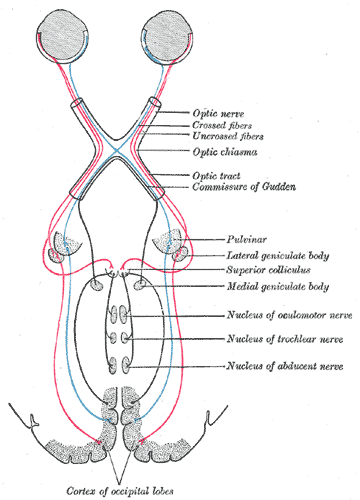 (5) Learning to run our brain: The eyes don’t see–the brain sees
(5) Learning to run our brain: The eyes don’t see–the brain sees
This is the fifth (5th) in a series of seven (7) articles showing all of us how to have more fun learning to run our very own brains more easily.

Illustration from Gray’s Anatomy; no higher resolution available. Image from Wikipedia: http://en.wikipedia.org/wiki/File:Gray722.png
…………………………………………………………………………………………………….
They eyes don’t see–the brain sees
The classic case is that of eyewitnesses to any event. The same event can produce radically dissimilar accounts from different witnesses, even if these witnesses were all in near proximity to each other.
An example is the university professor who arranged for an intruder to enter his lecture classroom suddenly and demand the professor’s wallet and then flee. The moment the brief “heist” was over, the professor explained that it was a prearranged dramatic event to test their ability to describe events when they were under pressure.
The students heaved a great sigh of relief, laughed, and immediately wrote a short account of what they had witnessed. Accounts varied, except for one common description of the weapon that the “thief” had used. All the students described it as a gun, or pistol, or revolver, or handgun.
The “weapon” was a banana. 😮
It is the brain that learns to read
When I was working with client (helping children overcome learning difficulties), I would always tell the parents to get the student’s eyes checked before I started my work. “We want to make sure the ‘equipment” works,” I would tell them, “before we start with my investigation of what the brain is doing.”
The parents would often tell me that their child’s vision had been checked by a specialist and that the child was wearing the prescribed corrective lens, or had been told s/he had perfect vision. And then the parents would often add, “If s/he sees well, why can’t s/he read well?”
Sometimes, to emphasize the situation, I would say, “The eyes don’t see–the brain sees.”
This helped all of us emphasize the understanding that while vision is important–of course–it is the brain that learns how to read. The eyes may have perfect 20/20 vision, and the student may still not have an easy time mastering reading.
The brain directs the eye focusing and movement patterns
The eyes have to focus at a point, and then they have to move in coordinated saccades (or “jumps”) in order to take in words or phrases as they move along the line of print.
It is the brain that runs these eye movement patterns, and it is the brain that has the complex task of making meaning out of a bunch of little sequential black markings in a piece of paper.
How, and in what ways, does the brain do this?
One way is discussed in a previous article posted here on THE LEARNING CLINIC WORLDWIDE blog, April 22, 2010. To read that article, simply click on the title below:
“My son reads, closes the book, and looks blank.”
Here’s to reading comprehension!
Doc Meek, Fri, July 2, 2010, at Sherwood Park, Alberta, CANADA
(Updated Sat, Oct 20, 2012)
—
“What if you are smarter than you think?”

THE LEARNING CLINIC WORLDWIDE, INC.
CANADA: Dr. Meek (587) 400-4707, Edmonton, AB
TONGA: Mele Taumoepeau, P.O. Box 81, Nuku’alofa
USA: Dr. Meek (801) 738-3763, South Jordan, Utah
For optimum brain health, get optimum heart health:
More on heart health: http://www.themeekteam.info
USA: Jeannette (801) 971-1812; South Jordan, Utah
CANADA: Jeannette (587) 333-6923, Calgary, Alberta
CANADA: P.O. Box 3105, Sherwood Park, AB T8H 2T1
=========================================

[…] (5) Learning to run our brain: The eyes don’t see–the brain sees […]